Understanding Eyebrow Tattoo Removal Techniques
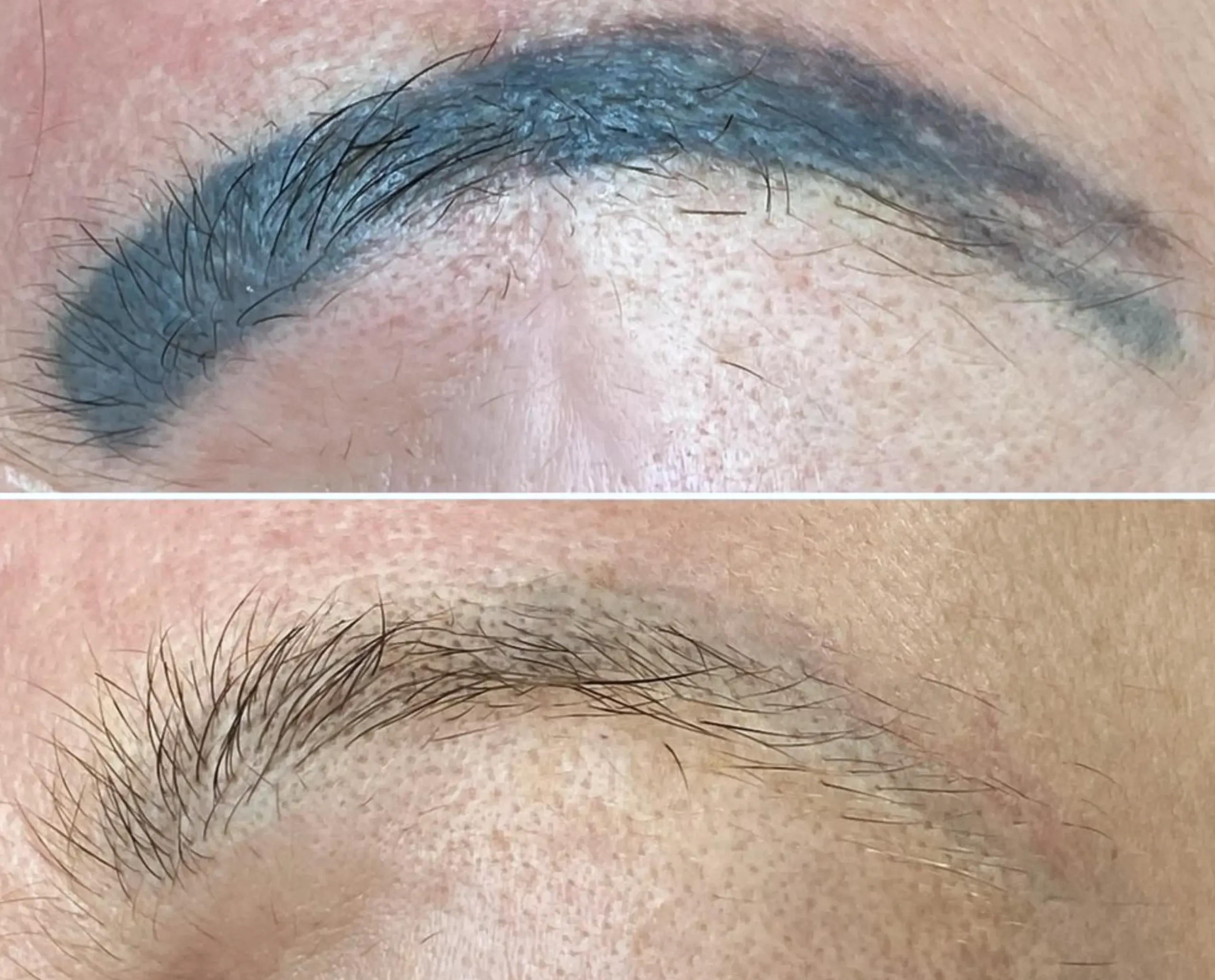
Introduction
Eyebrow tattoo removal is a popular practice among Australians who want to get rid of permanent make-up. Due to changing fashion styles, dissatisfaction with the results of cosmetic tattooing or personal reasons it is important for one to know the different techniques available. This article looks at various eyebrow tattoo removal methods, what each method does and how they work regarding technology behind them as well as their suitability vis a vis one’s skin type and type of tattoo pigments.
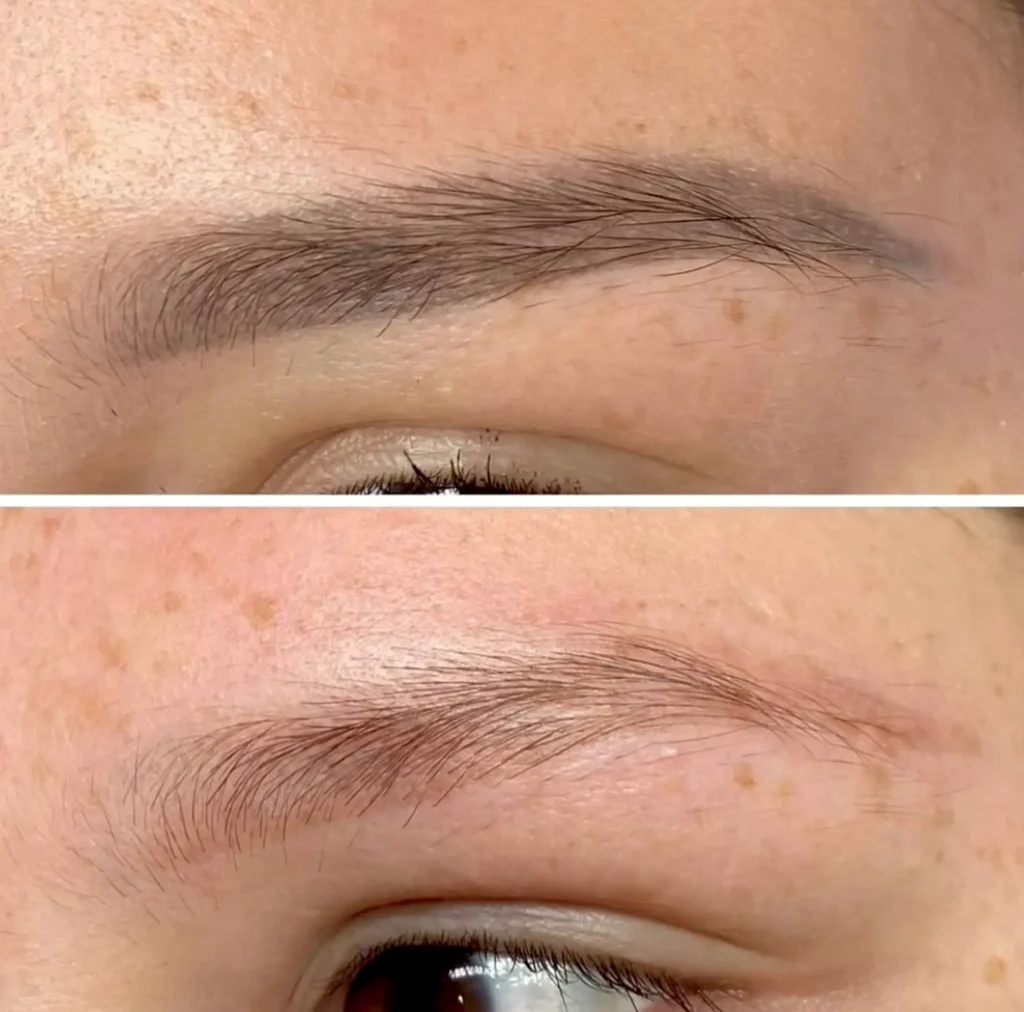
Why People Choose to Remove Eyebrow Tattoos
Even though eyebrow tattoos are liked by many people since they enhance natural beauty, there are times when they may need to be removed. Several reasons can make an individual go for this process. For instance, when a person has change in style of dressing. Over time brow shapes have changed and the old fashioned ones might not look good any longer. At other times however, the desired final look may not be obtained from cosmetic tattooing due to some reasons discussed below:
Another critical factor is that inked eyebrows naturally fade away with time. When used for eyebrow tattooing purposes, the pigments can degrade and change color thus producing an unappealing appearance on someone’s face. Factors such as sun exposure, ink type used and an individual’s skin type can speed up this fading mechanism. In this case, therefore, these tattoos stop matching their initial shades hence appearing awful and patchy.
Overview of Eyebrow Tattoo Removal Methods
There are various techniques that are often used when addressing issues related to brow tattoos’ eradication from one’s face. Therefore it is very important for you to understand how each works so that you will be able to choose which among them suits you best.
Laser Tattoo Removal
Laser treatment is often regarded as being more effective than other methods when it comes down on removing eye brow tats. It employs a laser machine that emits light energy causing the tattoo pigment particles on the skin to break. By avoiding damage to surrounding tissues and by focusing on ink, this approach lowers its impact area thereby increasing efficiency.
Suitability for Skin Types
Laser treatment is appropriate even for patients having a wide range of skin colors; however, its effectiveness may vary from one individual to another. On the other hand, there is a greater chance of hypopigmentation or hyperpigmentation among people with dark complexion. To minimize these risks, an experienced cosmetic tattooist specialized in laser eyebrow tattoo removal utilizes advanced laser equipments and modifies treatment course appropriately.
Suitability for Tattoo Pigments
Moreover, efficientity of laser tattoo removal depends on some factors such as type of ink used. Although some colours like black or dark brown respond well to the procedure while others such as yellow and white do not easily come out due to absorption differences by different pigments during which affects the amount of light energy absorbed by them through this process thus hindering removability.

Dermabrasion
Dermabrasion is also commonly used for removing eyebrow tattoos. It involves using a high-speed rotary instrument with an abrasive brush or wheel that removes layers of dead skin cells which are known to have been penetrated by color pigments thus making it possible for sanding off permanently marked areas. This method has more side effects compared to lasers treatments because it may require longer recovery time frames.
Considerations to Make for Different Skin Types
People with lighter skin tones are often better candidates for dermabrasion as there is less risk of scarring and pigmentation problems. Nevertheless, individuals with sensitive skin or conditions like acne scars should be cautious when using this method because it could worsen the damage already present on the skin and even cause further trauma.
Efficacy on Diverse Tattoo Forms
The effectiveness of dermabrasion depends mostly on the depth and age of the tattoo. Older tattoos that have started losing their original color might be easier to remove as compared to more recent ones which may need intensive treatment sessions. Additionally, Derma abrasion may not be an effective approach in some kinds of cosmetic tattoos particularly those having stubborn pigments.
Surgical Excision
Surgical excision is a last resort option for those wishing eyebrow tattoo removal especially where other methods have failed or total removal is required. This entails cutting out the tattooed section and stitching back the remaining ones surgically. Though highly successful, this method has higher chances of leaving a scar behind and making one take long before he/she fully recovers from it.
When to Opt for Surgical Excision
Generally, surgical excision should be done when dealing with small tattoos or cases where complete removal is necessary with precision. It does not work well in large complex designs due to the possibility of having significant scarring and tissue injury. The extent that this procedure will succeed can easily be determined through initial consults between a good surgeon and patient by considering parameters such as type of skin among others.
Recovery and Care
After surgical excision, it may take weeks before healing is complete while proper aftercare instructions must strictly be followed throughout this period. Patients should avoid infection or any chance of scaring hence there is need to adhere to some specific instructions concerning post-surgery recovery such as keeping affected areas clean, no direct sunlight exposure as well as applying prescribed antibacterial creams.
Factors Influencing the Choice of Removal Technique
Different factors have to be taken into account when deciding on how best to remove an eyebrow tattoo. For instance, pain tolerance is important because some ways such as surgical excision may be more painful than others. Laser treatment tends to cause less discomfort and in many cases anesthesia is used; but, there are also those treatments which require several sessions before it can totally be removed from the skin.
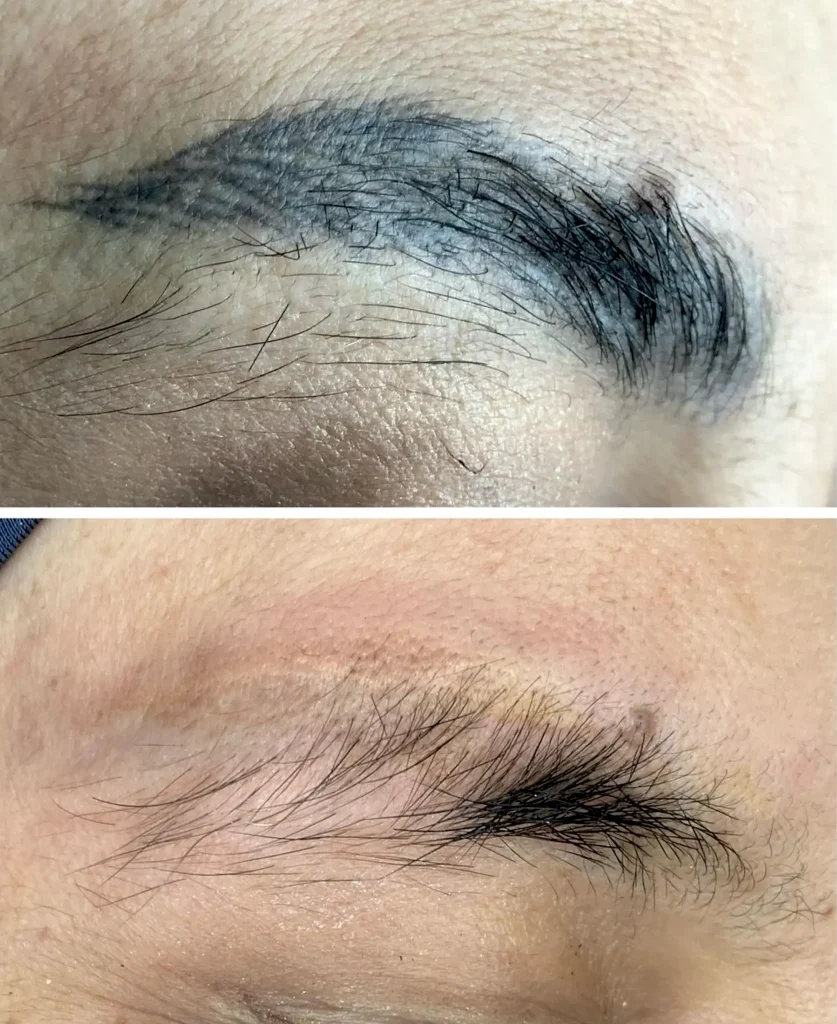
The cost is a key determinant as well. Multiple laser tattoo removals can accumulate costs especially if numerous treatments are needed for these purposes. While dermabrasion and surgical excision may require fewer sessions, they pose greater risks and may take longer durations to recuperate. It is thus necessary to evaluate each alternative’s costs against its efficacy and side effects which come with them.
| Method | Pain Level | Healing Time | Risk of Scarring | Number of Sessions | Cost |
|---|---|---|---|---|---|
| Laser Removal | Moderate | 4-6 weeks | Low | Multiple | High |
| Dermabrasion | High | 6-8 weeks | Moderate | Few | Moderate |
| Surgical Excision | Very High | 8-12 weeks | High | One | High |
Each method offers its own pros and cons, making it necessary to speak to a professional tattoo removal specialist who can advice you on the best approach for you as an individual.
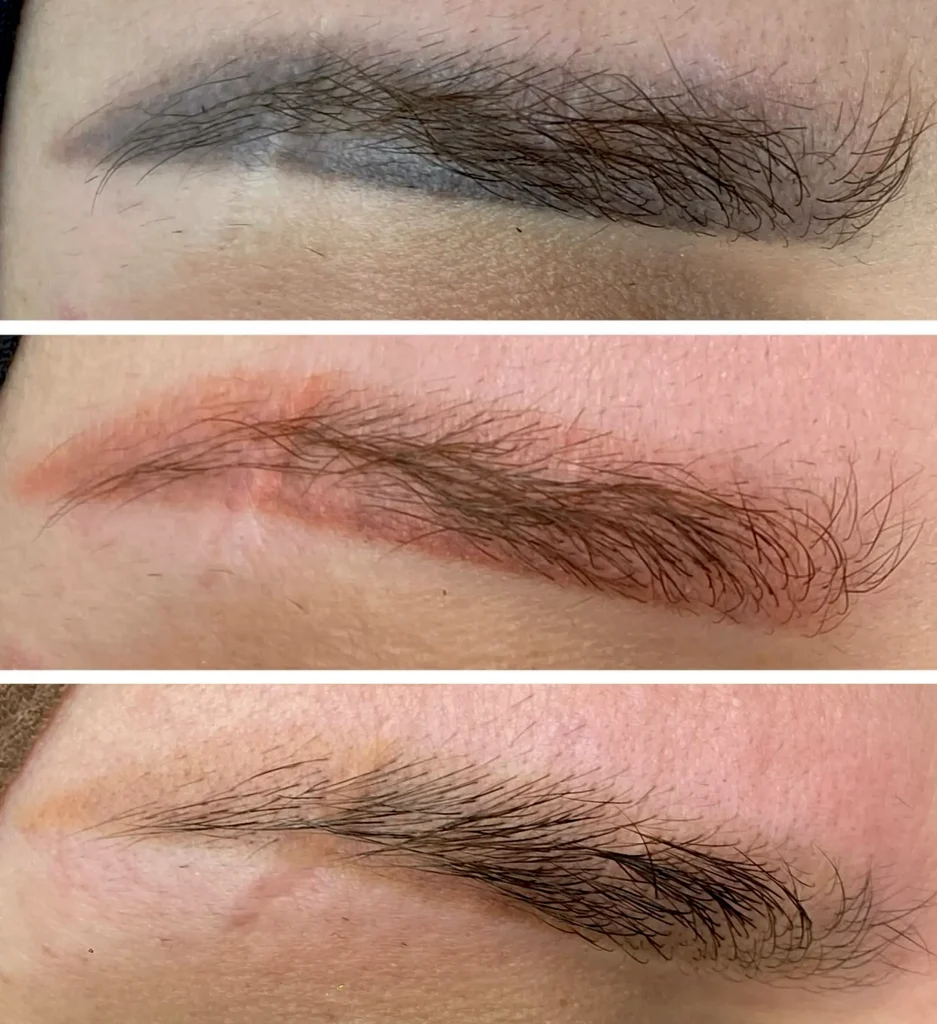
Common Aftercare Practices
Proper aftercare is vital in ensuring the best results from any eyebrow tattoo removal procedure. After laser tattoo removal sessions, patients must adhere to specific instructions for aftercare that help boost healing and reduce chances of complications such as avoiding sun exposure, applying ice packs to minimize swelling, keeping the area clean and dry.
After dermabrasion or surgical excision, however, the aftercare process becomes more involved. This may include regular wound care, avoiding strenuous activities and attending follow-up appointments for monitoring progress of healing. Utilizing antibacterial creams while following techniques advised by health professionals can aid in preventing infections and minimizing scarring. Pristine medical grade techniques are often recommended.
Two Vital Tips on Aftercare:
- Avoid Direct Sun Exposure: The skin that has been treated can be damaged by direct sunlight which causes pigmentation problems. When going outside you should therefore protect this part with some clothing or high-SPF sunscreen.
- Stay Hydrated: Drinking a lot of water helps the body heal naturally; it also aids in flushing out broken-down particles of ink from tattoos faster.
Conclusion
To make an informed choice that suits your needs exactly it is essential to comprehend various methods of eyebrow tattoo removal. However different methods like laser treatment, dermabrasion or surgical excision have their own peculiarities and merits. Speaking with either a cosmetic tattoo artist or a medical doctor will give you valuable insights and guide you in choosing an effective solution for removing your eyebrow tattoos. It is important to remember that proper aftercare practices plus patience yield better results towards restoring your original beauty.
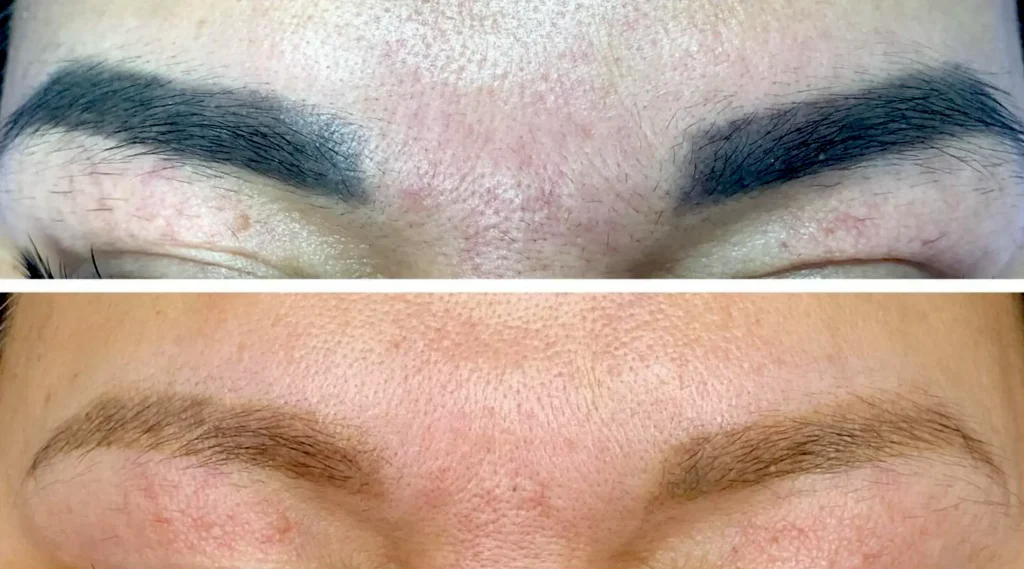
Frequently Asked Questions
What technique provides the most effective eyebrow tattoo removal?
Usually effectiveness hinges upon one’s skin type among other factors like age of the tattoo itself and the ink used. Laser tattoo removal is often considered most effective in general because of its ability to target various colours of ink and its precision.
How many sessions are typically needed for laser tattoo removal?
On average, six to eight sessions apart by several weeks are required to achieve significant fading or total elimination in case of laser eyebrow tattoo removal. The number of lasering sessions depends on such things as size, depth, and color.
Can eyebrow tattoo removal cause permanent scarring?
Though there is always a risk of scars when removing a tattoo through any method; laser has less risks than dermabrasion or surgical excision. However, if you care about your result it is recommended that you adhere to proper aftercare instructions given by experienced professionals only.
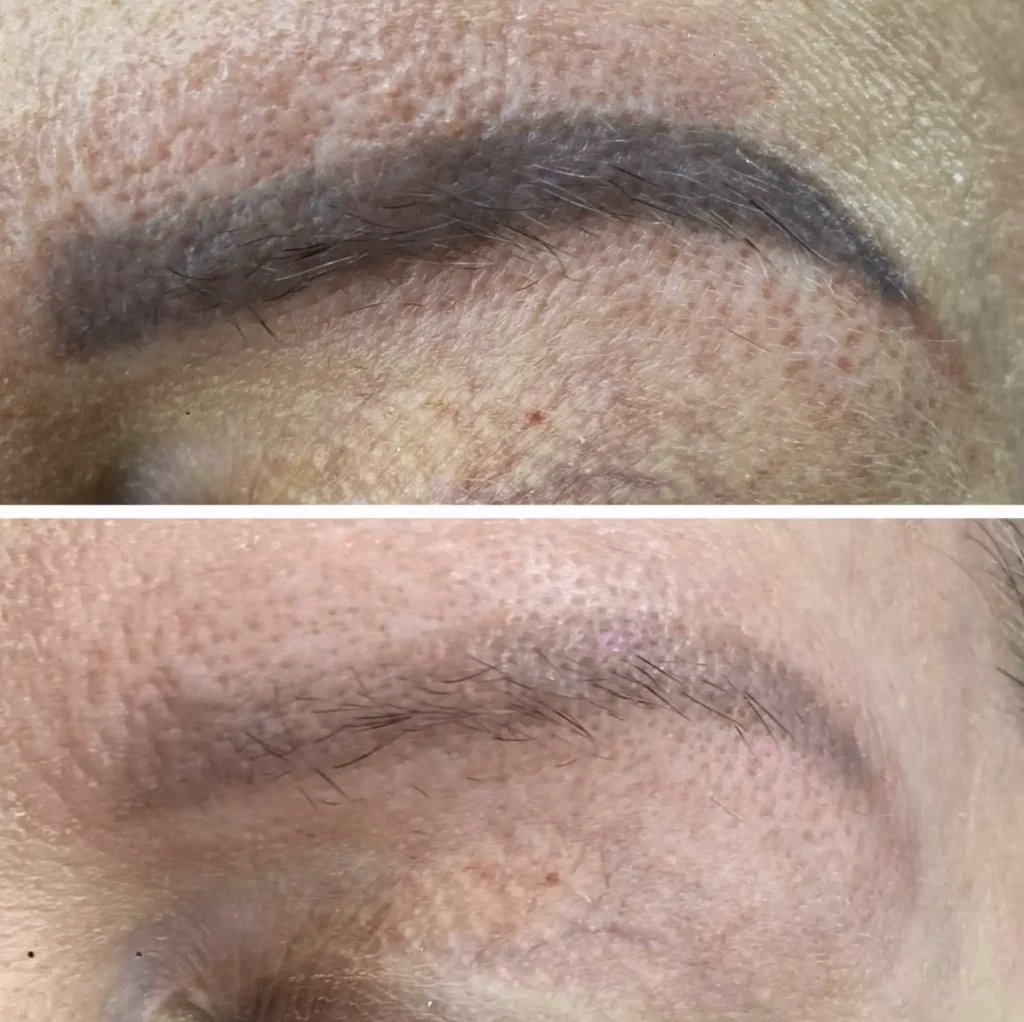
Is eyebrow tattoo removal painful?
The pain level differs depending on the approach used. On an average, moderate pain associated with numbing creams or local anesthesia may be caused by laser removal and dermabrasion. Conversely, this procedure is carried out under general anesthesia due to its high level of pain during the operation.
Are there any aftercare tips to follow post-eyebrow tattoo removal?
Yes, following aftercare tips is vital for a smooth recovery. For instance avoid direct sunlight exposure onto one’s face without anything covering it: keep away from it when lying down near sunshine rays coming through windows; apply some antibacterial ointment if told so by doctors; drink enough water so that your body can recover quickly as well as pass out remnants of untattooed areas easily.